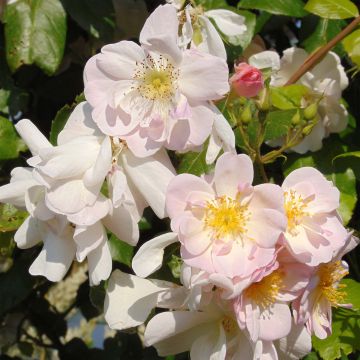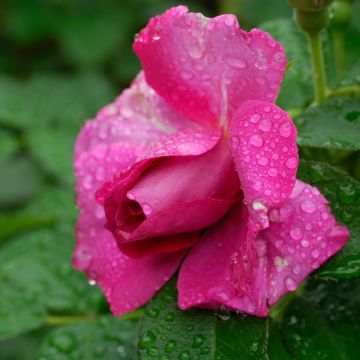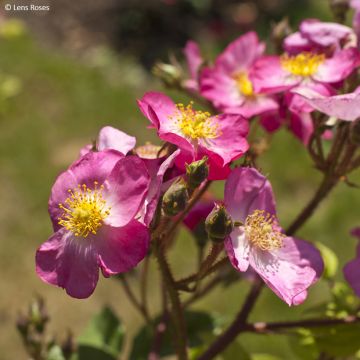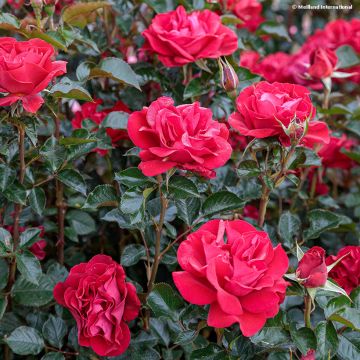Shipping country and language
Your country of residence may be:
Your country of residence is:
For a better user experience on our website, you can select:
Your shipping country:
Andorra
Austria
Belgium
Bulgaria
Canada
Chile
Croatia
Cyprus
Czechia
Denmark
Estonia
Finland
France
Germany
Greece
Hungary
Iceland
Ireland
Italy
Latvia
Lithuania
Luxembourg
Malta
Monaco
Netherlands
Poland
Portugal
Romania
Slovakia
Slovenia
Spain
Sweden
Switzerland
United Kingdom
We only deliver seed and bulb products to your country. If you add other products to your basket, they cannot be shipped.
Language:
French
German
Spanish
English
My Account
Hello
My wish lists
Plantfit
Log in / Register
Existing customer?
New customer?
Create an account to track your orders, access our customer service and, if you wish, make the most of our upcoming offers.


Rosa Basyes Purple
Rosa Basyes Purple
Rosa x rugosa Basye's Purple Rose
Rugosa Rose, Japanese Rose
Order in the next for dispatch today!
Dispatch by letter from €3.90.
Delivery charge from €5.90 Oversize package delivery charge from €6.90.
More information
This item is not available in your country.
Schedule delivery date,
and select date in basket
This plant carries a 24 months recovery warranty
More information
We guarantee the quality of our plants for a full growing cycle, and will replace at our expense any plant that fails to recover under normal climatic and planting conditions.
From €5.90 for pickup delivery and €6.90 for home delivery
Express home delivery from €8.90.
From €5.90 for pickup delivery and €6.90 for home delivery
Express home delivery from €8.90.
Does this plant fit my garden?
Set up your Plantfit profile →
Description
'Basye's Purple' Rose is a rare, dark and magnificent rose, born in 1968, in the USA, from a happy marriage between Rosa rugosa and Rosa foliolosa. It is unique in that it forms black stems, a dark purple juvenile foliage, and bears large solitary flowers, simple in their form, but painted with a sumptuous purple-black fading into burgundy red, a colour magnified by a silky texture. They renew themselves throughout the beautiful season on a large, slightly thorny, very vigorous bush, perfectly hardy, also free from diseases. When autumn comes, its grape-coloured fruits contrast beautifully with the golden yellow foliage.
Rosa 'Basye's Purple' has the genes of Rosa rugosa, a vigorous rose from the Far East, forming impenetrable thickets due to its dense and very thorny vegetation, and Rosa foliolosa, a curious botanical species, low and very suckering originating from the east of North America. 'Basye's Purple' is a creation of Dr Robert E. Basye, a Texan mathematics professor, passionate about roses. The plant forms a large bush or a small climber with an upright and dense habit, reaching 1.50m (4ft 11in) to 2m (6ft 7in) in height, with a width of 1m (3ft 4in). Almost all parts of this rose have a connection to the colour black. The foliage, abundant down to the base of the plant, is composed of leaves with a crinkled appearance, with serrated edges, divided into 5 to 9 fairly dark green leaflets tinged with purple, shiny. Its beautiful single and solitary flowers, quite large, composed of 5 very wide and thin petals, of a crimson purple colour maturing into burgundy, have the appearance of velvet and silk. They bloom from summer to autumn, but are devoid of fragrance. Its large dark red fruits are fleshy and edible, very rich in vitamin C.
Very hardy and almost maintenance-free, it is perfect for gardens without gardeners. If the passion for botanical roses and their direct hybrids is not widespread, it is fully justified, especially in poor soils or under difficult climates: these roses are not only the parents of our modern roses, but also generally more robust and very reliable. Rosa 'Basye's Purple' is a floriferous, powerful but light rose, which captures attention from spring to late autumn. It will find its place in a hedgerow or defensive bocage, a slightly wild garden, accompanied by a mauve rose ('Rhapsody in Blue', 'Veilchenblau'), a colour that suits its theatrical style so well. It can be accompanied by bushes or spindle trees for autumn colours, lilacs with their fragrant spring blooms, mock oranges for the same reason, but also viburnums that show a very accommodating character like him. Finally, it is a tolerant shrub towards the soil, splendid also when trained as a small climber.
Rosa Basyes Purple in pictures


Plant habit
Flowering
Foliage
Botanical data
Rosa
x rugosa
Basye's Purple Rose
Rosaceae
Rugosa Rose, Japanese Rose
Cultivar or hybrid
Rosa canina Laxa (Wrapped bare root, 4L/5L pot)
Other Traditional Roses A to Z
Planting and care
'Basye's Purple' Rose is undemanding, it thrives in all regions that are not too hot, is not afraid of diseases, cold, rain, or occasionally waterlogged soils. It adapts to any type of soil, as long as the planting is well cared for! Plant it in well-worked, well-amended, and well-drained ordinary soil, and in a sunny or partially shaded exposure, which it tolerates very well. To maintain a bushy habit, maintenance is simple: after winter, every 2 years, remove the oldest branches (2-3 years old). Very hardy, this rose can withstand temperatures as low as -20°C (-4 °F). It can be useful to remove dead wood in winter and to remove faded flowers. If necessary, in spring, after the risk of frost, a light pruning can be done. This variety sometimes tends to sucker, which makes it even more robust.
To plant your rose, whether in a pot or in open ground, work the soil to a depth of 25cm (9.8in), crumble the soil well, and place a base amendment such as dried blood or dehydrated horn at the bottom of the planting hole. Position your plant, freed from its pot, by covering the top of the root ball with 3cm (1.2in) of soil, backfill and water generously to remove any air pockets. In dry weather, regular watering is necessary for a few weeks to facilitate root development. Also, remember to provide your rose with special rose fertilizer that stimulates plant flowering. To achieve abundant flowering of your roses, regularly bend and tie the branches. Each bend will result in a lateral shoot that ends in a bouquet of flowers. Do not hesitate to use this technique, you will be rewarded. Regularly remove faded flowers.
Roses are often stained or look ugly at the end of summer, but this is not a problem for their development. These stains are not dangerous for the rose, it is a natural phenomenon.
Planting period
Intended location
Care
This item has not been reviewed yet - be the first to leave a review about it.
Traditional Roses
Haven't found what you were looking for?
Hardiness is the lowest winter temperature a plant can endure without suffering serious damage or even dying. However, hardiness is affected by location (a sheltered area, such as a patio), protection (winter cover) and soil type (hardiness is improved by well-drained soil).

Photo Sharing Terms & Conditions
In order to encourage gardeners to interact and share their experiences, Promesse de fleurs offers various media enabling content to be uploaded onto its Site - in particular via the ‘Photo sharing’ module.
The User agrees to refrain from:
- Posting any content that is illegal, prejudicial, insulting, racist, inciteful to hatred, revisionist, contrary to public decency, that infringes on privacy or on the privacy rights of third parties, in particular the publicity rights of persons and goods, intellectual property rights, or the right to privacy.
- Submitting content on behalf of a third party;
- Impersonate the identity of a third party and/or publish any personal information about a third party;
In general, the User undertakes to refrain from any unethical behaviour.
All Content (in particular text, comments, files, images, photos, videos, creative works, etc.), which may be subject to property or intellectual property rights, image or other private rights, shall remain the property of the User, subject to the limited rights granted by the terms of the licence granted by Promesse de fleurs as stated below. Users are at liberty to publish or not to publish such Content on the Site, notably via the ‘Photo Sharing’ facility, and accept that this Content shall be made public and freely accessible, notably on the Internet.
Users further acknowledge, undertake to have ,and guarantee that they hold all necessary rights and permissions to publish such material on the Site, in particular with regard to the legislation in force pertaining to any privacy, property, intellectual property, image, or contractual rights, or rights of any other nature. By publishing such Content on the Site, Users acknowledge accepting full liability as publishers of the Content within the meaning of the law, and grant Promesse de fleurs, free of charge, an inclusive, worldwide licence for the said Content for the entire duration of its publication, including all reproduction, representation, up/downloading, displaying, performing, transmission, and storage rights.
Users also grant permission for their name to be linked to the Content and accept that this link may not always be made available.
By engaging in posting material, Users consent to their Content becoming automatically accessible on the Internet, in particular on other sites and/or blogs and/or web pages of the Promesse de fleurs site, including in particular social pages and the Promesse de fleurs catalogue.
Users may secure the removal of entrusted content free of charge by issuing a simple request via our contact form.
The flowering period indicated on our website applies to countries and regions located in USDA zone 8 (France, the United Kingdom, Ireland, the Netherlands, etc.)
It will vary according to where you live:
- In zones 9 to 10 (Italy, Spain, Greece, etc.), flowering will occur about 2 to 4 weeks earlier.
- In zones 6 to 7 (Germany, Poland, Slovenia, and lower mountainous regions), flowering will be delayed by 2 to 3 weeks.
- In zone 5 (Central Europe, Scandinavia), blooming will be delayed by 3 to 5 weeks.
In temperate climates, pruning of spring-flowering shrubs (forsythia, spireas, etc.) should be done just after flowering.
Pruning of summer-flowering shrubs (Indian Lilac, Perovskia, etc.) can be done in winter or spring.
In cold regions as well as with frost-sensitive plants, avoid pruning too early when severe frosts may still occur.
The planting period indicated on our website applies to countries and regions located in USDA zone 8 (France, United Kingdom, Ireland, Netherlands).
It will vary according to where you live:
- In Mediterranean zones (Marseille, Madrid, Milan, etc.), autumn and winter are the best planting periods.
- In continental zones (Strasbourg, Munich, Vienna, etc.), delay planting by 2 to 3 weeks in spring and bring it forward by 2 to 4 weeks in autumn.
- In mountainous regions (the Alps, Pyrenees, Carpathians, etc.), it is best to plant in late spring (May-June) or late summer (August-September).
The harvesting period indicated on our website applies to countries and regions in USDA zone 8 (France, England, Ireland, the Netherlands).
In colder areas (Scandinavia, Poland, Austria...) fruit and vegetable harvests are likely to be delayed by 3-4 weeks.
In warmer areas (Italy, Spain, Greece, etc.), harvesting will probably take place earlier, depending on weather conditions.
The sowing periods indicated on our website apply to countries and regions within USDA Zone 8 (France, UK, Ireland, Netherlands).
In colder areas (Scandinavia, Poland, Austria...), delay any outdoor sowing by 3-4 weeks, or sow under glass.
In warmer climes (Italy, Spain, Greece, etc.), bring outdoor sowing forward by a few weeks.



















